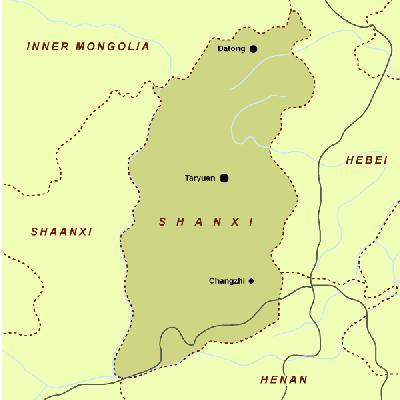| Map |
|
|
Shanxi
Shanxi has a continental monsoonal climate with distinctive seasons. It has cold winters but mild summers, with a mean annual temperature of 6oC to 14oC. The greater part of the province has a mean annual precipitation of 400-650 mm, increasing gradually from northwest to southeast.
It is divided into 1 district, 10 prefecture-level cities, 12 county-level cities and 85 counties, with a population of 32.97 million as of 2000, mainly including ethnic groups of Han, Hui, Mongolian and Manchu.
Daoxiao Mian (Knife-Pared Noodles), Shaomai (steamed dumplings with the dough gathered at the top), and Youmian (Naked Oats Noodles), etc.
The traditional specialties are Fen wine, Zhuyeqing wine, Qingxu vinegar and Changzhi ginseng.
Shanxi Bangzi (a kind of opera in Shanxi), Huagu (Flower Drum), and Yangge (popular rural folk dance), etc.
Shanxi, Jin for short, is situated on the middle segment of the Yellow River. The land of Shanxi is one of the origins of Chinese civilization, exhibiting evidence of human settlement over a million years ago. Huangdi (the Yellow Emperor), a famous legendary hero, apparently sojourned in Shanxi, and the earliest rulers, Yao, Shun and Yu, all founded their capitals there. Datong, known as Pingcheng in ancient times, was the capital of the Northern Wei Dynasty (386-534) and famous throughout the Southern and Northern Dynasties (420-581). During the Sui (581-618) and Tang (618-907) Dynasties, Shanxi became very prosperous. In the past, Shanxi people were once called the Chinese Jews, indicating that they were people of wisdom. The long history of Shanxi has provided the province with a rich and colorful cultural heritage.
The basins here are the main agricultural region. The most important products are wheat, corn, cotton and peanut. Shanxi is the base of coal industry. The produces of heavy machinery and textile are very important in the whole country. Also, there is iron and steel, electric power, chemical industry, textile and food. The communication is mainly railway. And the highway here is convenient, too.
There are abundant historic reserves in Shanxi, including Wutai Mountain, Hengshan Mountain, the Jin Ancestral Hall in Taiyuan, the Yungan Grottos in Datong, the Shuanglin Temple in Pingyao, the Hanging Temple in Hunyuan, and the Hukou Waterfall of the Yellow River. |
||||
 |
 Geography
Geography
 Climate
Climate Administrative Division and
Population
Administrative Division and
Population Food
Food  Special Local Products
Special Local Products Culture
Culture  Brief Introduction
Brief Introduction